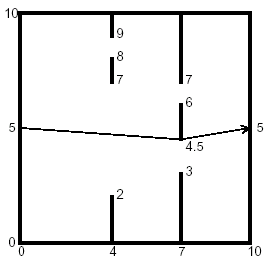The Doors
| Time Limit: 1000MS | Memory Limit: 10000K | |
| Total Submissions: 7430 | Accepted: 2915 |
Description
You are to find the length of the shortest path through a chamber containing obstructing walls. The chamber will always have sides at x = 0, x = 10, y = 0, and y = 10. The initial and final points of the path are always (0, 5) and (10, 5). There will also be from 0 to 18 vertical walls inside the chamber, each with two doorways. The figure below illustrates such a chamber and also shows the path of minimal length.


Input
The input data for the illustrated chamber would appear as follows.
2
4 2 7 8 9
7 3 4.5 6 7
The first line contains the number of interior walls. Then there is a line for each such wall, containing five real numbers. The first number is the x coordinate of the wall (0 < x < 10), and the remaining four are the y coordinates of the ends of the doorways in that wall. The x coordinates of the walls are in increasing order, and within each line the y coordinates are in increasing order. The input file will contain at least one such set of data. The end of the data comes when the number of walls is -1.
2
4 2 7 8 9
7 3 4.5 6 7
The first line contains the number of interior walls. Then there is a line for each such wall, containing five real numbers. The first number is the x coordinate of the wall (0 < x < 10), and the remaining four are the y coordinates of the ends of the doorways in that wall. The x coordinates of the walls are in increasing order, and within each line the y coordinates are in increasing order. The input file will contain at least one such set of data. The end of the data comes when the number of walls is -1.
Output
The
output should contain one line of output for each chamber. The line
should contain the minimal path length rounded to two decimal places
past the decimal point, and always showing the two decimal places past
the decimal point. The line should contain no blanks.
Sample Input
1 5 4 6 7 8 2 4 2 7 8 9 7 3 4.5 6 7 -1
Sample Output
10.00 10.06
Source
【思路】
枚举所有点,如果不与竖边相交则连边,做最短路即可。
【代码】

1 #include<cmath> 2 #include<cstdio> 3 #include<cstring> 4 #include<algorithm> 5 #define FOR(a,b,c) for(int a=(b);a<=(c);a++) 6 using namespace std; 7 8 const int N = 300+10; 9 const double INF = 1e9; 10 const double eps = 1e-8; 11 12 int dcmp(double x) { 13 if(x<eps) return 0; else return x<0? -1:1; 14 } 15 16 struct Pt { 17 double x,y; 18 Pt(double x=0,double y=0):x(x),y(y) {}; 19 }; 20 struct Seg { Pt a1,a2; }; 21 typedef Pt vec; 22 23 vec operator - (Pt A,Pt B) { return vec(A.x-B.x,A.y-B.y); } 24 bool operator != (Pt A,Pt B) { 25 if(dcmp(A.x-B.x)==0 && dcmp(A.y-B.y)==0) return 0; 26 else return 1; 27 } 28 29 double cross(Pt A,Pt B) { return A.x*B.y-A.y*B.x; } 30 31 bool SegInter(Pt s1, Pt e1, Pt s2, Pt e2) { 32 if( 33 cross(e1-s1,s2-s1) * cross(e1-s1,e2-s1) <= 0 && 34 cross(e2-s2,s1-s2) * cross(e2-s2,e1-s2) <= 0 35 ) return true; 36 return false; 37 } 38 double dist(Pt a,Pt b) { 39 return sqrt((a.x-b.x)*(a.x-b.x)+(a.y-b.y)*(a.y-b.y)); 40 } 41 double f[N][N]; 42 Seg L[N]; int lc; 43 Pt P[N]; int pc; 44 int n; 45 46 int main() { 47 while(scanf("%d",&n)==1 && n>0) { 48 pc=lc=0; 49 FOR(i,1,n) { 50 double x,y1,y2,y3,y4; 51 scanf("%lf%lf%lf%lf%lf",&x,&y1,&y2,&y3,&y4); 52 L[++lc]=(Seg) {Pt(x,0),Pt(x,y1)}; 53 L[++lc]=(Seg) {Pt(x,y2),Pt(x,y3)}; 54 L[++lc]=(Seg) {Pt(x,y4),Pt(x,10)}; 55 P[++pc]=Pt(x,y1) , P[++pc]=Pt(x,y2); 56 P[++pc]=Pt(x,y3) , P[++pc]=Pt(x,y4); 57 } 58 P[++pc]=Pt(0,5), P[++pc]=Pt(10,5); 59 FOR(i,1,pc) FOR(j,1,pc) f[i][j]=INF; 60 FOR(i,1,pc) FOR(j,i+1,pc) { 61 bool flag=1; 62 FOR(k,1,lc) 63 if(SegInter(P[i],P[j],L[k].a1,L[k].a2)) 64 { flag=0; break; } 65 if(flag) 66 f[i][j]=f[j][i]=dist(P[i],P[j]); 67 } 68 FOR(i,1,n) { 69 FOR(j,i+1,n) if(f[i][j]!=INF) 70 printf("%d,%d : %.2lf ",i,j,f[i][j]); 71 } 72 FOR(k,1,pc) FOR(i,1,pc) FOR(j,1,pc) 73 f[i][j]=min(f[i][j],f[i][k]+f[k][j]); 74 printf("%.2lf ",f[pc-1][pc]); 75 } 76 return 0; 77 }
